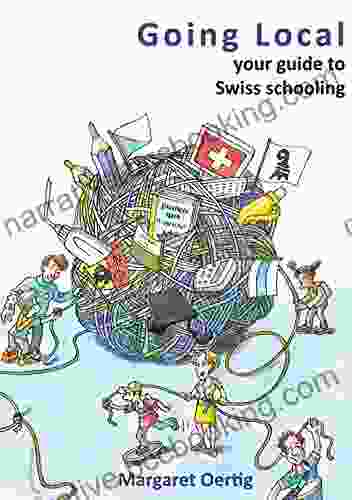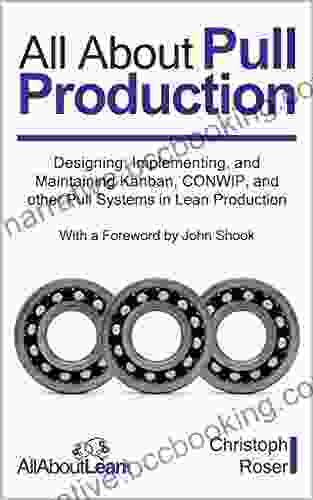All About Pull Production: The Ultimate Guide to Lean Manufacturing

In today's competitive global market, businesses are constantly striving for ways to improve their efficiency and profitability. Pull Production, a key pillar of lean manufacturing, has emerged as a powerful tool to achieve these goals. This comprehensive guide will delve into the essence of Pull Production, exploring its principles, benefits, and implementation strategies. Embark on this journey to discover how Pull Production can transform your manufacturing operations and propel your business to new heights of success.
4.9 out of 5
| Language | : | English |
| File size | : | 66212 KB |
| Text-to-Speech | : | Enabled |
| Screen Reader | : | Supported |
| Enhanced typesetting | : | Enabled |
| Word Wise | : | Enabled |
| Print length | : | 443 pages |
| Lending | : | Enabled |
Chapter 1: Understanding the Pull Production Philosophy
Pull Production is a customer-driven manufacturing strategy that aims to eliminate waste and optimize resource utilization. Unlike traditional push systems, which produce goods based on forecasts, Pull Production only produces what is needed, when it is needed. This approach aligns production with actual demand, resulting in reduced inventory, increased flexibility, and improved product quality.
Key Principles of Pull Production:
- Customer Focus: Pull Production prioritizes meeting customer requirements and delivering value.
- Flow Production: Goods are produced in a continuous, value-adding flow, minimizing bottlenecks and improving throughput.
- Visual Management: Visual cues, such as kanban cards, help to visualize the flow of work and identify areas for improvement.
- Standardization: Processes are standardized to ensure consistency and reduce variation.
- Continuous Improvement: Pull Production embraces a culture of continuous learning and improvement, seeking to eliminate waste and enhance efficiency.
Chapter 2: Benefits of Implementing Pull Production
Adopting Pull Production can bring numerous benefits to manufacturing organizations, including:
Reduced Waste:
Pull Production eliminates overproduction, one of the seven deadly wastes in manufacturing. By producing only what is needed, businesses can significantly reduce inventory levels and avoid the associated costs of storage, obsolescence, and waste.
Improved Quality:
Pull Production emphasizes continuous improvement and defect prevention. By focusing on producing goods only when they are demanded, manufacturers can identify and eliminate quality issues early in the process, leading to higher product quality and customer satisfaction.
Increased Flexibility:
Pull Production systems are highly adaptable and can respond quickly to changing customer demands. By eliminating bottlenecks and reducing lead times, businesses can increase their flexibility and competitiveness in a rapidly evolving market.
Enhanced Productivity:
Pull Production optimizes the utilization of resources, including equipment, labor, and materials. By eliminating waste and improving flow, businesses can increase their overall productivity and reduce operational costs.
Chapter 3: Key Elements of Pull Production Systems
Implementing Pull Production successfully requires the integration of several key elements:
Kanban:
Kanban cards are visual signals that trigger the production of goods. They indicate the quantity and type of product required at each stage of the production process, ensuring that production is in sync with demand.
Just-in-Time (JIT) Production:
JIT production aims to deliver materials, components, and finished goods to the right place, at the right time, and in the right quantity. This approach minimizes inventory and reduces waste.
Jidoka:
Jidoka is a Japanese term that refers to the ability of machines to detect and stop themselves when a defect occurs. This helps to prevent the production of defective products and ensures product quality.
Continuous Improvement:
Pull Production systems embrace a culture of continuous improvement, known as Kaizen in Japanese. This involves actively seeking ways to eliminate waste, improve processes, and enhance productivity.
Chapter 4: Implementing Pull Production in Your Organization
Successfully implementing Pull Production requires a comprehensive and structured approach. Here are the key steps to consider:
Step 1: Assess Your Current State:
Conduct a thorough analysis of your current manufacturing operations to identify areas for improvement. Understand your demand patterns, inventory levels, and waste.
Step 2: Design the Pull Production System:
Based on your assessment, develop a detailed design for your Pull Production system. Determine the kanban system, JIT processes, and quality control measures you will implement.
Step 3: Train and Educate Your Team:
Empower your employees with the knowledge and skills necessary to operate the Pull Production system effectively. Conduct comprehensive training programs to ensure a smooth transition.
Step 4: Implement and Monitor the System:
Gradually implement the Pull Production system while closely monitoring its performance. Make adjustments as needed based on feedback and data analysis.
Step 5: Continuous Improvement:
Establish a culture of continuous improvement to sustain the benefits of Pull Production. Regularly review your system, identify areas for further improvement, and implement necessary changes.
Chapter 5: Case Studies and Success Stories
Discover real-world examples of organizations that have successfully implemented Pull Production and reaped its benefits. Learn from their experiences and gain valuable insights into how Pull Production can transform your manufacturing operations.
Chapter 6:
Pull Production is not merely a technique but a philosophy that drives continuous improvement and manufacturing excellence. By embracing the principles of Pull Production, businesses can unlock a world of benefits, including reduced waste, improved quality, increased flexibility, and enhanced productivity. The journey to Pull Production is an ongoing one, but it is a journey that will lead to lasting success and competitiveness in today's dynamic manufacturing landscape.
Invest in 'All About Pull Production' today and embark on the path to manufacturing excellence. Join the ranks of organizations that have harnessed the power of Pull Production to transform their operations and achieve extraordinary results.
Free Download your copy now and unlock the secrets of Pull Production!
4.9 out of 5
| Language | : | English |
| File size | : | 66212 KB |
| Text-to-Speech | : | Enabled |
| Screen Reader | : | Supported |
| Enhanced typesetting | : | Enabled |
| Word Wise | : | Enabled |
| Print length | : | 443 pages |
| Lending | : | Enabled |
Do you want to contribute by writing guest posts on this blog?
Please contact us and send us a resume of previous articles that you have written.
 Book
Book Novel
Novel Page
Page Chapter
Chapter Text
Text Story
Story Genre
Genre Reader
Reader Library
Library Paperback
Paperback E-book
E-book Magazine
Magazine Newspaper
Newspaper Paragraph
Paragraph Sentence
Sentence Bookmark
Bookmark Shelf
Shelf Glossary
Glossary Bibliography
Bibliography Foreword
Foreword Preface
Preface Synopsis
Synopsis Annotation
Annotation Footnote
Footnote Manuscript
Manuscript Scroll
Scroll Codex
Codex Tome
Tome Bestseller
Bestseller Classics
Classics Library card
Library card Narrative
Narrative Biography
Biography Autobiography
Autobiography Memoir
Memoir Reference
Reference Encyclopedia
Encyclopedia Christine Hyung Oak Lee
Christine Hyung Oak Lee Christen Brown
Christen Brown Chris Stewart
Chris Stewart Charles Staley
Charles Staley Chris Fry
Chris Fry Catherine Ryan Gregory
Catherine Ryan Gregory Charlotte Moore
Charlotte Moore Charles Leerhsen
Charles Leerhsen Christopher Lane
Christopher Lane Christopher Reutinger
Christopher Reutinger Cheryl Marlene
Cheryl Marlene Christopher Edmonds
Christopher Edmonds Christopher Burris
Christopher Burris Chuck Weikert
Chuck Weikert Christopher Hampton
Christopher Hampton Charlotte Eliopoulos
Charlotte Eliopoulos Cecelia Dowdy
Cecelia Dowdy Catherine S Gregory
Catherine S Gregory Charles R Swindoll
Charles R Swindoll Charles Fleming
Charles Fleming
Light bulbAdvertise smarter! Our strategic ad space ensures maximum exposure. Reserve your spot today!

 Edgar CoxJourney into the Heart of War: An American Advisor's Unforgettable Account of...
Edgar CoxJourney into the Heart of War: An American Advisor's Unforgettable Account of... Corey GreenFollow ·8.8k
Corey GreenFollow ·8.8k Orson Scott CardFollow ·5.3k
Orson Scott CardFollow ·5.3k Anton FosterFollow ·13.3k
Anton FosterFollow ·13.3k Efrain PowellFollow ·12.4k
Efrain PowellFollow ·12.4k Duane KellyFollow ·5.2k
Duane KellyFollow ·5.2k Finn CoxFollow ·6.7k
Finn CoxFollow ·6.7k Jared PowellFollow ·5.1k
Jared PowellFollow ·5.1k Henry Wadsworth LongfellowFollow ·14k
Henry Wadsworth LongfellowFollow ·14k

 J.R.R. Tolkien
J.R.R. TolkienEscape to the Culinary Paradise: "Truck Stop Deluxe In...
Prepare your palate for an...

 Andres Carter
Andres CarterA Taste of the Unusual: Discover the Enchanting World of...
Prepare to be captivated by "Cindy Supper...

 Nick Turner
Nick TurnerChild Obesity: Introducing the Idea of Healthy Weight
Child obesity is a serious...

 Junot Díaz
Junot DíazGoing Local: Your Ultimate Guide to Swiss Schooling |...
In the heart of Europe, Switzerland boasts a...

 Raymond Parker
Raymond ParkerSir Cumference and the Dragon of Pi: A Mathematical Fable
In the enchanting realm of...

 Thomas Powell
Thomas PowellUnveiling the Enchanting Realm of Curious Creatures from...
Russian folklore is a rich tapestry of...
4.9 out of 5
| Language | : | English |
| File size | : | 66212 KB |
| Text-to-Speech | : | Enabled |
| Screen Reader | : | Supported |
| Enhanced typesetting | : | Enabled |
| Word Wise | : | Enabled |
| Print length | : | 443 pages |
| Lending | : | Enabled |









